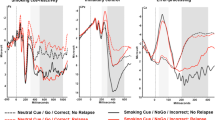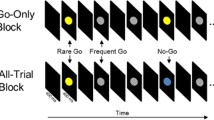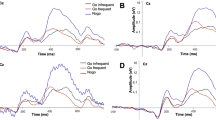Abstract
Smoking during adolescence may promote nicotine dependence later on in life. Therefore, it is extremely important to study the neural mechanisms of adolescent smokers. As inhibition control is emphasized in several contemporary theoretical models of addiction, in the current study, we focused on the electrophysiological evidence of inhibition control deficits in adolescent smokers. By using relatively homogenous groups of adolescent smokers (n = 18) and matched nonsmokers (n = 18), we employed event-related potentials (ERP) to investigate the N200 and P300 amplitude and latency differences during a Go/NoGo task between the adolescent smokers and nonsmokers. Relative to nonsmokers, more NoGo response errors, reduced NoGo P300 amplitude, and longer P300 latency were observed in adolescent smokers. Correlation analysis revealed that the NoGo P300 amplitudes were significantly correlated with NoGo errors in both adolescent smokers and nonsmokers. Our findings provided direct electrophysiological evidence for inhibitory control impairments in adolescent smokers. It is hoped that our results may enhance understanding of the pathology of inhibitory control in adolescent smokers.



Similar content being viewed by others
References
Albert J., López-Martín S., Hinojosa J. A., & Carretié L. (2013). Spatiotemporal characterization of response inhibition. NeuroImage, 76, 272–281.
Band G., & Van Boxtel G. (1999). Inhibitory motor control in stop paradigms: review and reinterpretation of neural mechanisms. Acta Psychologica, 101(2), 179–211.
Bokura H., Yamaguchi S., & Kobayashi S. (2005). Event-related potentials for response inhibition in Parkinson’s disease. Neuropsychologia, 43(6), 967–975.
Bokura, H., Yamaguchi, S., Matsubara, M., & Kobayashi, S. (2002). Frontal lobe contribution to response inhibition process—an ERP study and aging effect. In International Congress Series, 2002 (Vol. 1232, pp. 17–20): Elsevier
Casey B. (2015). Beyond simple models of self-control to circuit-based accounts of adolescent behavior. Annual Review of Psychology, 66, 295–319.
Casey B., Tottenham N., Liston C., & Durston S. (2005). Imaging the developing brain: what have we learned about cognitive development? Trends in Cognitive Sciences, 9(3), 104–110.
Cohen H., Porjesz B., Begleiter H., & Wang W. (1997). Neurophysiological correlates of response production and inhibition in alcoholics. Alcoholism: Clinical and Experimental Research, 21(8), 1398–1406.
Dimoska A., & Johnstone S. J. (2008). Effects of varying stop-signal probability on ERPs in the stop-signal task: do they reflect variations in inhibitory processing or simply novelty effects? Biological Psychology, 77(3), 324–336.
Dong G., Lu Q., Zhou H., & Zhao X. (2010). Impulse inhibition in people with internet addiction disorder: electrophysiological evidence from a go/NoGo study. Neuroscience Letters, 485(2), 138–142.
Eissenberg T. (2004). Measuring the emergence of tobacco dependence: the contribution of negative reinforcement models. Addiction, 99(s1), 5–29.
Enriquez-Geppert S., Konrad C., Pantev C., & Huster R. J. (2010). Conflict and inhibition differentially affect the N200/P300 complex in a combined go/nogo and stop-signal task. NeuroImage, 51(2), 877–887.
Euser A. S., Arends L. R., Evans B. E., Greaves-Lord K., Huizink A. C., & Franken I. H. (2012). The P300 event-related brain potential as a neurobiological endophenotype for substance use disorders: a meta-analytic investigation. Neuroscience & Biobehavioral Reviews, 36(1), 572–603.
Evans D., Park J., Maxfield N., & Drobes D. (2009). Neurocognitive variation in smoking behavior and withdrawal: genetic and affective moderators. Genes, Brain and Behavior, 8(1), 86–96.
Fagerstrom K.-O., & Schneider N. G. (1989). Measuring nicotine dependence: a review of the fagerstrom tolerance questionnaire. Journal of Behavioral Medicine, 12(2), 159–182.
Falkenstein M. (2006). Inhibition, conflict and the nogo-N2. Clinical Neurophysiology, 117(8), 1638–1640.
Falkenstein M., Hoormann J., & Hohnsbein J. (1999). ERP components in go/nogo tasks and their relation to inhibition. Acta Psychologica, 101(2), 267–291.
Folstein J. R., & Van Petten C. (2008). Influence of cognitive control and mismatch on the N2 component of the ERP: a review. Psychophysiology, 45(1), 152–170.
Fu, L.-p., Bi, G.-h., Zou, Z.-t., Wang, Y., Ye, E.-m., Ma, L., et al. (2008). Impaired response inhibition function in abstinent heroin dependents: an fMRI study. Neuroscience Letters, 438(3), 322–326.
Galván A., Poldrack R. A., Baker C. M., McGlennen K. M., & London E. D. (2011). Neural correlates of response inhibition and cigarette smoking in late adolescence. Neuropsychopharmacology, 36(5), 970–978.
Glantz, S. A., & Parmley, W. W. (1991). Passive smoking and heart disease. Epidemiology, physiology, and biochemistry. Circulation, 83(1), 1–12.
Goldstein R. Z., & Volkow N. D. (2002). Drug addiction and its underlying neurobiological basis: neuroimaging evidence for the involvement of the frontal cortex. American Journal of Psychiatry, 159(10), 1642–1652.
Goldstein R. Z., & Volkow N. D. (2011). Dysfunction of the prefrontal cortex in addiction: neuroimaging findings and clinical implications. Nature Reviews Neuroscience, 12(11), 652–669.
Groman S. M., James A. S., & Jentsch J. D. (2009). Poor response inhibition: at the nexus between substance abuse and attention deficit/hyperactivity disorder. Neuroscience & Biobehavioral Reviews, 33(5), 690–698.
Huster R., Westerhausen R., Pantev C., & Konrad C. (2010). The role of the cingulate cortex as neural generator of the N200 and P300 in a tactile response inhibition task. Human Brain Mapping, 31(8), 1260–1271.
Jentsch J. D., & Taylor J. R. (1999). Impulsivity resulting from frontostriatal dysfunction in drug abuse: implications for the control of behavior by reward-related stimuli. Psychopharmacology, 146(4), 373–390.
Jonkman L. M. (2006). The development of preparation, conflict monitoring and inhibition from early childhood to young adulthood; a go/nogo ERP study. Brain Research, 1097(1), 181–193.
Kamarajan C., Porjesz B., Jones K. A., Choi K., Chorlian D. B., Padmanabhapillai A., et al. (2005). Alcoholism is a disinhibitory disorder: neurophysiological evidence from a go/no-go task. Biological Psychology, 69(3), 353–373.
Kaufman J. N., Ross T. J., Stein E. A., & Garavan H. (2003). Cingulate hypoactivity in cocaine users during a GO-NOGO task as revealed by event-related functional magnetic resonance imaging. The Journal of Neuroscience, 23(21), 7839–7843.
Keylock C. J. B., Galvin J. R., & Franks T. J. (2009). Sclerosing hemangioma of the lung. Archives of Pathology & Laboratory Medicine, 133(5), 820–825.
Kiefer M., Marzinzik F., Weisbrod M., Scherg M., & Spitzer M. (1998). The time course of brain activations during response Inhibition: evidence From event‐Related potentials In a go/no go Task. Neuroreport, 9(4), 765–770.
Kirmizi-Alsan E., Bayraktaroglu Z., Gurvit H., Keskin Y. H., Emre M., & Demiralp T. (2006). Comparative analysis of event-related potentials during go/NoGo and CPT: decomposition of electrophysiological markers of response inhibition and sustained attention. Brain Research, 1104(1), 114–128.
Kok A., Ramautar J. R., De Ruiter M. B., Band G. P., & Ridderinkhof K. R. (2004). ERP components associated with successful and unsuccessful stopping in a stop‐signal task. Psychophysiology, 41(1), 9–20.
Li Y., Yuan K., Cai C., Feng D., Yin J., Bi Y., et al. (2015). Reduced frontal cortical thickness and increased caudate volume within fronto-striatal circuits in young adult smokers. Drug and Alcohol Dependence.
Littel M., Berg I., Luijten M., Rooij A. J., Keemink L., & Franken I. H. (2012). Error processing and response inhibition in excessive computer game players: an event‐related potential study. Addiction Biology, 17(5), 934–947.
Lubman D. I., Yücel M., & Pantelis C. (2004). Addiction, a condition of compulsive behaviour? Neuroimaging and neuropsychological evidence of inhibitory dysregulation. Addiction, 99(12), 1491–1502.
Luijten, M., Littel, M., & Franken, I. H. (2011). Deficits in inhibitory control in smokers during a go/NoGo task: an investigation using event-related brain potentials. PloS One, 6(4), e18898.
Luijten M., Machielsen M. W., Veltman D. J., Hester R., de Haan L., & Franken I. H. (2014). Systematic review of ERP and fMRI studies investigating inhibitory control and error processing in people with substance dependence and behavioural addictions. Journal of Psychiatry & neuroscience: JPN, 39(3), 149.
Lydon D. M., Wilson S. J., Child A., & Geier C. F. (2014). Adolescent brain maturation and smoking: what we know and where we’re headed. Neuroscience & Biobehavioral Reviews, 45, 323–342.
McEvoy L. K., Pellouchoud E., Smith M. E., & Gevins A. (2001). Neurophysiological signals of working memory in normal aging. Cognitive Brain Research, 11(3), 363–376.
Nestor L., McCabe E., Jones J., Clancy L., & Garavan H. (2011). Differences in “bottom-up” and “top-down” neural activity in current and former cigarette smokers: evidence for neural substrates which may promote nicotine abstinence through increased cognitive control. NeuroImage, 56(4), 2258–2275.
Nieuwenhuis S., Yeung N., Van Den Wildenberg W., & Ridderinkhof K. R. (2003). Electrophysiological correlates of anterior cingulate function in a go/no-go task: effects of response conflict and trial type frequency. Cognitive, Affective, & Behavioral Neuroscience, 3(1), 17–26.
O’Loughlin J., DiFranza J., Tyndale R. F., Meshefedjian G., McMillan-Davey E., Clarke P., et al. (2003). Nicotine-dependence symptoms are associated with smoking frequency in adolescents. American Journal of Preventive Medicine, 25(3), 219–225.
Pires L., Leitão J., Guerrini C., & Simões M. R. (2014). Event-related brain potentials in the study of inhibition: cognitive control, source localization and age-related modulations. Neuropsychology Review, 24(4), 461–490.
Polich J. (2007). Updating P300: an integrative theory of P3a and P3b. Clinical Neurophysiology, 118(10), 2128–2148.
Polich J., & Criado J. R. (2006). Neuropsychology and neuropharmacology of P3a and P3b. International Journal of Psychophysiology, 60(2), 172–185.
Shucard J. L., McCabe D. C., & Szymanski H. (2008). An event-related potential study of attention deficits in posttraumatic stress disorder during auditory and visual go/NoGo continuous performance tasks. Biological Psychology, 79(2), 223–233.
Silveri, M. M., Tzilos, G. K., Pimentel, P. J., & YURGELUN‐TODD, D. A. (2004). Trajectories of adolescent emotional and cognitive development: effects of sex and risk for drug use. Annals of the New York Academy of Sciences, 1021(1), 363–370.
Singh S. M., & Basu D. (2009). CLINICAL STUDY: the P300 event‐related potential and its possible role as an endophenotype for studying substance use disorders: a review. Addiction Biology, 14(3), 298–309.
Sokhadze E., Stewart C., Hollifield M., & Tasman A. (2008). Event-related potential study of executive dysfunctions in a speeded reaction task in cocaine addiction. Journal of Neurotherapy, 12(4), 185–204.
Stock A. K., Schulz T., Lenhardt M., Blaszkewicz M., & Beste C. (2014). High‐dose alcohol intoxication differentially modulates cognitive subprocesses involved in response inhibition. Addiction biology.
Sussman, S. (2002). Effects of sixty six adolescent tobacco use cessation trials and seventeen prospective studies of self-initiated quitting. Tobacco Induced Diseases, 1(1), 35–81.
Swan G. E., & Lessov-Schlaggar C. N. (2007). The effects of tobacco smoke and nicotine on cognition and the brain. Neuropsychology Review, 17(3), 259–273.
Taioli E., & Wynder E. L. (1991). Effect of the age at which smoking begins on frequency of smoking in adulthood. The New England Journal of Medicine, 325(13), 968–969.
Verdejo-García A., Lawrence A. J., & Clark L. (2008). Impulsivity as a vulnerability marker for substance-use disorders: review of findings from high-risk research, problem gamblers and genetic association studies. Neuroscience & Biobehavioral Reviews, 32(4), 777–810.
White, H. R., Bray, B. C., Fleming, C. B., & Catalano, R. F. (2009). Transitions into and out of light and intermittent smoking during emerging adulthood. Nicotine & Tobacco Research, ntn017.
Xing L., Yuan K., Bi Y., Yin J., Cai C., Feng D., et al. (2014). Reduced fiber integrity and cognitive control in adolescents with internet gaming disorder. Brain Research, 1586, 109–117.
Yuan, K., Cheng, P., Dong, T., Bi, Y., Xing, L., Yu, D., et al. (2013a). Cortical thickness abnormalities in late adolescence with online gaming addiction. PloS One, 8(1), e53055.
Yuan, K., Jin, C., Cheng, P., Yang, X., Dong, T., Bi, Y., et al. (2013b). Amplitude of low frequency fluctuation abnormalities in adolescents with online gaming addiction. PloS One, 8(11), e78708.
Yuan K., Qin W., Yu D., Bi Y., Xing L., Jin C., et al. (2015). Core brain networks interactions and cognitive control in internet gaming disorder individuals in late adolescence/early adulthood. Brain Structure and Function, 1-16.
Zhou Z. H., Yuan G. Z., Yao J. J., Li C., & Cheng Z. H. (2010). An event‐related potential investigation of deficient inhibitory control in individuals with pathological internet use. Acta Neuropsychiatrica, 22(5), 228–236.
Acknowledgments
This paper is supported by the Project for the National Key Basic Research and Development Program (973) under Grant nos. 2014CB543203, 2011CB707700, 2012CB518501, the National Natural Science Foundation of China under Grant nos. 81401478, 81401488, 81271644, 81271546, 81271549, 81470816, 81471737, 81301281, the Natural Science Basic Research Plan in Shaanxi Province of China under Grant no. 2014JQ4118, and the Fundamental Research Funds for the Central Universities under the Grant nos. 8002–72135767, 8002–72145760, the Natural Science Foundation of Inner Mongolia under Grant no. 2012MS0908. General Financial Grant the China Post- doctoral Science Foundation under Grant no. 2014 M552416.
Conflict of Interest
Junsen Yin, Kai Yuan, Dan Feng, Jiadong Cheng, Yangding Li, Chenxi Cai, Yanzhi Bi, Shi Sha, Xiaomin Shen, Ben Zhang, Ting Xue, Wei Qin, Dahua Yu, Xiaoqi Lu, and Jie Tian declare that they have no conflicts of interest.
Author information
Authors and Affiliations
Corresponding authors
Rights and permissions
About this article
Cite this article
Yin, J., Yuan, K., Feng, D. et al. Inhibition control impairments in adolescent smokers: electrophysiological evidence from a Go/NoGo study. Brain Imaging and Behavior 10, 497–505 (2016). https://doi.org/10.1007/s11682-015-9418-0
Published:
Issue Date:
DOI: https://doi.org/10.1007/s11682-015-9418-0




